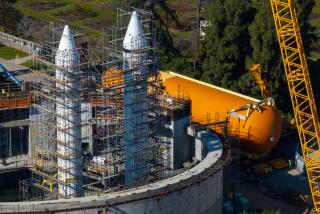Unidentified Floating Object : Huge Oil Field Device Makes a Splash When It Barges Into Harbor on Way to Alaska
- Share via
It was 10 stories tall, it weighed 10 million pounds, and when it floated into Los Angeles Harbor it turned a lot of heads.
One of those heads was Russ Knapp’s.
“I was up there at seaman’s center in San Pedro picking up my mail and when I came out and saw it I said, ‘Now what the hell is that?,’ ” said Knapp, 72, a retired professional seaman. That was a huge device called a gas handling module, 5,000 tons’ worth, that is slowly--very slowly--making its way up to the Prudhoe Bay oil fields in Alaska on the back of a 400-foot-long, 100-foot-wide barge. It looks sort of like a 100-foot-tall green and gray apartment building perched on a huge floating board.
Built in Louisiana, the mammoth contraption is one of three such modules that will be used in Alaska to separate natural gas from oil and then pump the gas back into the ground to “re-pressurize” the field and force out more oil.
All three gas-handling modules left Louisiana on June 4, towed by seagoing tugboats, and headed for the Panama Canal, passing through the locks with inches to spare on each side. According to Albert Greenstein, a spokesman for Arco, which is jointly sponsoring the project with other oil companies, the barges constituted what is believed to be the most cargo tonnage ever transported through the canal.
One of the barges stopped in Los Angeles Harbor on Tuesday so the tug could take on fuel, prompting several inquiries to the Marine Exchange in San Pedro, which monitors harbor traffic.
“We didn’t know what to tell them, because we didn’t know what it was either,” said a Marine Exchange official, who declined to be identified by name.
Other amateur harbor watchers called the local offices of Crowley Maritime Corp., which operates the tugs. Callers wanted to know 1) what was it? and 2) how could something so big and so boxlike actually float?
“It’s hard for people to imagine that it can float,” said Richard Simpson, a Crowley company vice president. “It takes a special expertise to handle something as large as this.”
It also takes a lot of time. The barges move through the ocean at an average speed of 5 or 6 knots, or about as fast as traffic on the South Bay Curve of the San Diego Freeway at 5 p.m. on the Friday before Memorial Day. Consequently, the 8,000-mile trip from Louisiana to Alaska is expected to take two months.
But Russ Knapp, one of several gawkers who stopped by Berths 45-46 in San Pedro to take a look at the “big thing,” wonders how the barges could get there at all.
“I don’t see how they’ll ever make it,” said Knapp, who usually hangs his hat in Roseburg, Ore., but jumped in his camper truck and drove down here a week ago with his dog Suzie to, as he put it, “to get away from the damned rain.”
“High as that thing is, it’s gotta be unstable,” he said. “It’s a wonder she ain’t tipped over already.”
Crowley official Simpson was considerably more confident.
“We’ve been doing this kind of thing for 20 years and we’ve never had one tip over yet,” he said. “They’ve got this down to a science.”
The barge left Los Angeles later Tuesday and continued on its long journey north. Once it arrives at Prudhoe Bay the module will be taken off the barge and transported 10 miles inland by a huge “rolling lift” that has 32 axles and 512 tires. Arco officials say the gas module project, which will cost about $1.2 billion, will help stem the decline of the field’s oil production.
More to Read
Sign up for Essential California
The most important California stories and recommendations in your inbox every morning.
You may occasionally receive promotional content from the Los Angeles Times.













